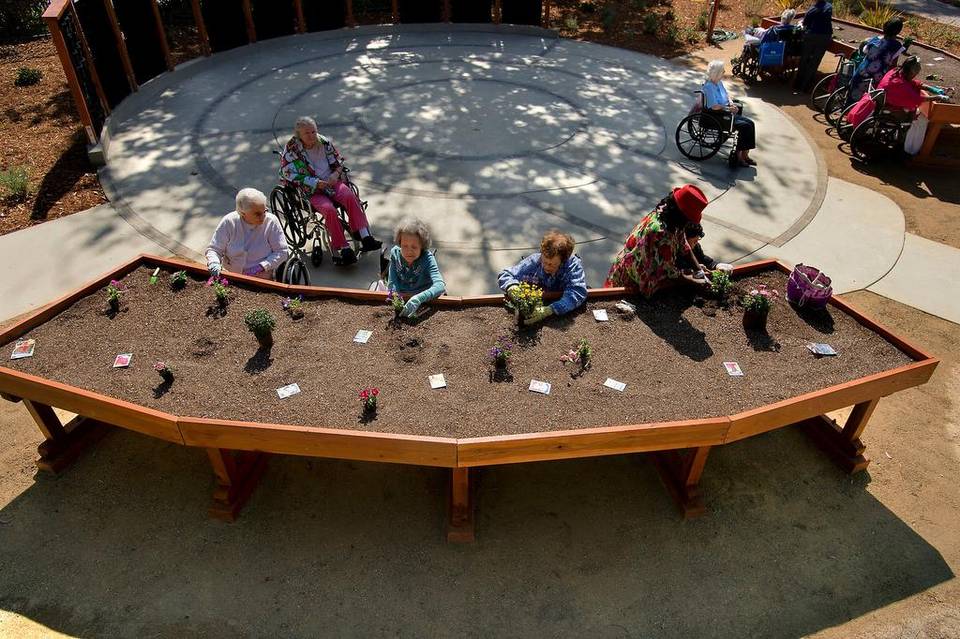BY DEBBIE ARRINGTON, Sacramento Bee
For decades, a large carpet of grass stretched across the central courtyard of Eskaton Care Center in Sacramento’s Greenhaven neighborhood.
In the best of summers, the lawn looked only OK, hampered by patches of shades thrown by the buildings and maturing trees. As the evergreens filled out, the beleaguered grass got less and less light.
Drought only made the kind-of-green space look more ragged. Instead of an uplifting oasis, the turf just looked sad.
 Photo by Randall Benton, Sacramento Bee
Photo by Randall Benton, Sacramento BeeWorse, Eskaton’s senior residents had trouble negotiating their wheelchairs and walkers across the lawn. Mobility issues made the grass a daunting obstacle. They wanted to be outside, to enjoy the sunshine and fresh air. But the turf limited their access.
Heather Craig, the center’s executive director, saw potential in this problem lawn. Instead of trying to nurse the turf back to greenness, the space could be revitalized with low-water landscaping. At the same time, its access could be much improved – for walking, rolling and gardening.
“We work on ambulation and balance on different surfaces,” Craig said. “That’s important for mobility.”
Herself a gardener, Craig is a firm believer in the healing qualities of gardening, which she said is a stress buster in many ways.
“Go out in the garden,” she recommended. “It’s a lot cheaper than a shrink.”
Craig wanted to incorporate a labyrinth into Eskaton. From her own experience in healing gardens, she found the winding path could lead to inner peace.
“A labyrinth is a place to go and meditate,” she explained. “As you walk through, you lose yourself in your surroundings. It’s a cleansing of your soul.”
With input from residents, the center developed a water-wise plan that could save the trees while cutting more than half of its water use. In addition, it would provide therapy space for residents recovering from strokes as well as raised garden beds with roll-up access for wheelchair-bound gardeners.
To fund the transformation, the center’s foundation, residents and families raised $330,000 in donations to replace the worn-out lawn with a healing garden. Its focal point: a wheelchair-accessible labyrinth.
California’s drought prompted quick action; the center had to cut its water use by at least 25 percent.
By early June, the lawn was gone, replaced by water-wise shrubs and perennials. Birds, bees and butterflies soon found these flowering replacements to the old Bermuda grass. In late summer, the center courtyard felt alive with this backyard wildlife.
“We’re not done yet,” Craig said. “We’re making a living wall.”
Black felt pockets line a 5-foot-high wooden frame, awaiting flowers, vegetables and herbs later this fall. Plants will grow vertically in this soil-less wall.
“You can already see the transformation,” she said. “It’s truly a therapeutic space.”
Hundreds of family and friends joined the residents for a grand opening celebration last month and garden dedication.
Ron Walker, 77, a retired firefighter and Eskaton resident, gardens from his wheelchair, having lost his left leg. He loves the new garden.
“I think it’s the best thing we’ve ever done by far,” Walker said. “It’s appealing to everyone who comes in here.”
Before, several residents liked to garden but had little sunny space to grow tomatoes and their favorite flowers. The lawn hogged all the available sunshine as well as a lot of water. Cutting back lawn irrigation also endangered the center’s many large trees, beloved by the residents for their beauty and shade.
“This was a huge, huge undertaking,” Walker said. “It’s really amazing. It’s more than a transformation from a lawn to a low-water landscape. It used to be basically an open field with grass. In winter, it turned into a lake. Now, residents will get a lot more use of this area.”
In early September, the Eskaton garden club members started planting fall vegetables and flowers in their new raised redwood beds. The soil sits at table height, making it easy for gardeners to feel the dirt between their fingers.
“I just love it,” said resident Rita O’Connor, 83, who suffered a minor stroke and now gardens from her wheelchair. “The garden is great therapy. You can sit in the garden and just look at the plants. They’re growing, getting bigger and better every day.
“I can do the same.”


